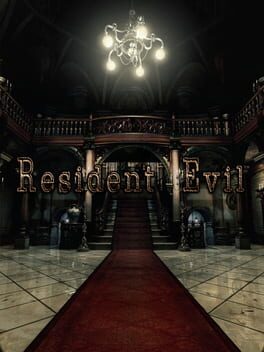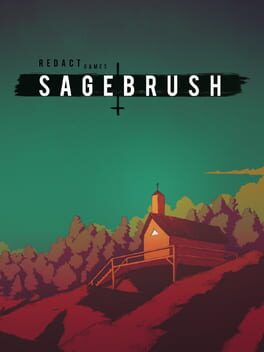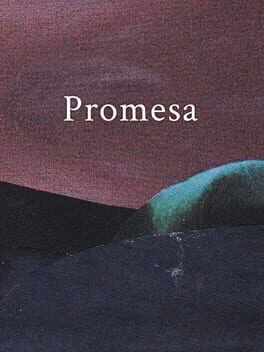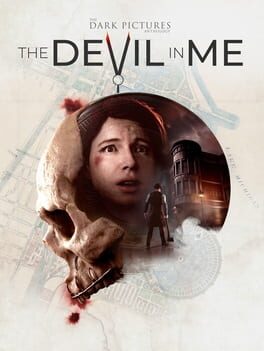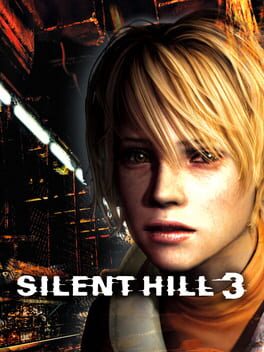pulpfuertes
Bio
back to games.. (again).
back to games.. (again).
Badges

Gone Gold
Received 5+ likes on a review while featured on the front page

Famous
Gained 100+ followers

Adored
Gained 300+ total review likes

Trend Setter
Gained 50+ followers

Best Friends
Become mutual friends with at least 3 others

3 Years of Service
Being part of the Backloggd community for 3 years

Loved
Gained 100+ total review likes

Well Written
Gained 10+ likes on a single review

Popular
Gained 15+ followers

Noticed
Gained 3+ followers

Liked
Gained 10+ total review likes
Favorite Games
096
Total Games Played
008
Played in 2024
000
Games Backloggd
Recently Played See More
Recently Reviewed See More
The conceit behind Supermassive Games’ body of horror games was a noble one to begin with. The simple idea of a playable slasher film pushed to the extreme; taking after the likes of “choose your own adventure” novels but most notably the interactive dramas of David Cage- which at this point stand as some of the most potent pieces of camp entertainment the medium has seen (that’s another conversation though). With Until Dawn they delivered on this promise with a game that was effectively curated in its tone and pacing, balancing between the joyful excesses of the genre with some genuinely visceral gnarliness (no doubt borrowing influence from Larry Fessenden who has a starring role in the game and had a pronounced hand in the writer’s room). After the game’s success, Supermassive went on to produce “The Dark Pictures Anthology” which was in essence a collection of ‘Until Dawn’ clones with what essentially felt like half the budget, production time, and length. The ambition had me excited but within the first hour of playing ‘Man of Medan’ I realized just how short it falls from their potential after how good Until Dawn was. Fast forward to now and we’re on ‘episode four’ of ‘season one’ of this project and its safe to say that Supermassive is utterly washed. I think I gave a lot of credit towards the bigger vision they were aspiring to but at this point I simply don’t have the patience for this brand of lazy, copy-paste development anymore- especially after seeing the refreshingly moderate effort placed into their spiritual successor to Until Dawn, 'The Quarry'.
Much of the appeal of horror to me is its sheer devotion to sensory affect and how far it can tease the participator, whether it be a film, novel, or video game. I believe with the latter medium we’re able to gauge the most potent application of the genre and what it can accomplish regarding the player’s interaction with the environment as well as other characters. There is literally so much you can do within the genre, so it makes it frustrating that Supermassive skimp and stumble away achieving the bare minimum almost every time. The typical slasher runs about eighty to ninety minutes so it’s shocking to me that these Dark Pictures games are en masse paced so poorly and proceed to take up an interminable six hours. It’s over an hour of gameplay for ‘The Devil In Me’ to reached its primarily location and half of that time is spent on a pointless opening set piece that acts as a tedious tutorial and also bears no real significance to the overarching story. The rest of this hour is its own dirge of setting up the ensemble’s dynamics and basic plot points in the blandest, most expositional manner possible- and rest assured reader, this is the worst and most cynical band of personalities Supermassive has conjured yet. Unfortunately, if not even Ashley Tisdale can sell the dialogue and development her character was given in House of Ashes, then Academy Award nominated Jessie Buckley certainly won’t here.
What's left beyond the uncanny valley-ass performances and the expressionless blocking in the cutscenes is a game that never moves at a natural pace; instead playing like being trapped in the apathetic body of a rusting tin man at all times as well as littered with jittery camera angles and glitches and lacking any sense of motivated lighting to add visual flourish or at the very least helpfully guide the player. As all these Dark Pictures titles go, once the violence ramps up its silly attempts at raising the pulse of the player get slightly more fruitful but as in the case of all the Dark Pictures titles, it's hollow thrills with no lasting resonance. No intricacies, nothing for the inquisitive player to glean or discover of its characters or setting that won't be explained away by the dialogue or needlessly made obvious in the lore newspaper clippings cluttered around the map. At the end of the day, there really was no point in me spending time writing about this prime example of dubious corporate horror when there's no shortage of real darkness in the world, but it's defeating when these small pleasures could be crafted to be so much better. If anything I feel as though this is a personal epitaph for a developer that suggests I may not be returning for 'season two'.
Much of the appeal of horror to me is its sheer devotion to sensory affect and how far it can tease the participator, whether it be a film, novel, or video game. I believe with the latter medium we’re able to gauge the most potent application of the genre and what it can accomplish regarding the player’s interaction with the environment as well as other characters. There is literally so much you can do within the genre, so it makes it frustrating that Supermassive skimp and stumble away achieving the bare minimum almost every time. The typical slasher runs about eighty to ninety minutes so it’s shocking to me that these Dark Pictures games are en masse paced so poorly and proceed to take up an interminable six hours. It’s over an hour of gameplay for ‘The Devil In Me’ to reached its primarily location and half of that time is spent on a pointless opening set piece that acts as a tedious tutorial and also bears no real significance to the overarching story. The rest of this hour is its own dirge of setting up the ensemble’s dynamics and basic plot points in the blandest, most expositional manner possible- and rest assured reader, this is the worst and most cynical band of personalities Supermassive has conjured yet. Unfortunately, if not even Ashley Tisdale can sell the dialogue and development her character was given in House of Ashes, then Academy Award nominated Jessie Buckley certainly won’t here.
What's left beyond the uncanny valley-ass performances and the expressionless blocking in the cutscenes is a game that never moves at a natural pace; instead playing like being trapped in the apathetic body of a rusting tin man at all times as well as littered with jittery camera angles and glitches and lacking any sense of motivated lighting to add visual flourish or at the very least helpfully guide the player. As all these Dark Pictures titles go, once the violence ramps up its silly attempts at raising the pulse of the player get slightly more fruitful but as in the case of all the Dark Pictures titles, it's hollow thrills with no lasting resonance. No intricacies, nothing for the inquisitive player to glean or discover of its characters or setting that won't be explained away by the dialogue or needlessly made obvious in the lore newspaper clippings cluttered around the map. At the end of the day, there really was no point in me spending time writing about this prime example of dubious corporate horror when there's no shortage of real darkness in the world, but it's defeating when these small pleasures could be crafted to be so much better. If anything I feel as though this is a personal epitaph for a developer that suggests I may not be returning for 'season two'.
𝘥𝘰𝘯'𝘵 𝘺𝘰𝘶 𝘵𝘩𝘪𝘯𝘬 𝘣𝘭𝘰𝘯𝘥𝘦𝘴 𝘩𝘢𝘷𝘦 𝘮𝘰𝘳𝘦 𝘧𝘶𝘯?
I’ve taken a considerable amount of time between my experiences with each of the main Silent Hill games. I played the first entry around six-seven years ago when I was still in a mutually toxic relationship and found it excellent yet downright baffling. Containing industrial and metallic horrors beyond immediate comprehension and freaky cults and oddly touching ‘chosen family’ dynamics, it pushed the limits for what I believed a PS1 title could achieve through sheer atmosphere and symbolic prowess alone. After nabbing a decently priced copy of the second game a year post my separation from said relationship (and in the wake of the pandemic), I found myself shattered by its oppressive deconstruction of a guilty conscience and the interconnective nature of trauma- both shared and isolated. How pain binds fractured souls together, and winds them up into botched and abstracted spaces of American normality to fend for themselves on a primal level. It took everything the first entry accomplished and confidently treks into bold territories that challenged the player’s allegiance to their supposed protagonist as well as call attention to their adjacent relationships to side characters- who upon the surface don’t directly contribute much to James’ arc but rather gracefully ebb and flow with the intention of supplementing the themes of the story. These first two games were exhausting to push through, almost sadist in quality and punishing in developer motivation with how they marry deeply complicated and expressionistic narratives with deliberately stunted and claustrophobic gameplay. They are, to me, a primordial testament to what the medium can achieve as singular works of art (as well as propelling the interactive possibilities of horror).
Anyways, Backloggd word salad aside, it has been nearly four years and I have finally gotten to the trilogy capper. I have since healed from my own personal traumas from the relationship that haunted my experiences with the previous two games (but still write the inflated wordy nonsense on here for the four people that actually read my reviews). That word, “healed”, succinctly captures what it felt like to play through Silent Hill III. It is an encompassing coming of age narrative about origin and birthright and interrogates the identity that we are born with versus the one we ultimately choose for ourselves. The game also wraps itself back into the thematic backbone of the first game in a clever way, weaving in ideas of evangelic persecution that removes women’s agency from their bodies and intertwining that with emotional struggles of familial belonging. Team Silent fills the game with the adequate amount of angst, grief, and sass that any teenage girl confronts as they are exposed to the chronic realities of impending adulthood. And yes, it is also very scary; utilizing some fairly cursed sound work and utterly hideous (and frequently phallic) creature designs in addition to incorporating another deliciously brooding soundtrack by Akira Yamaoka. Everything in this game carries the instinct to exercise hostility and discomfort towards Heather. Who didn’t feel that way about the world as an insecure adolescent? At the very least the sense that nothing is quite “okay” permeates much of the game’s wildly structured first half leading up to the story’s venture to the titular town in the second. The player navigates through malls, subway stations, construction sites, office buildings, and apartment complexes with the overall goal of getting home and then from there we are thrust into the familiar spaces we’ve walked before as other characters.
Despite its messy development, this is as much an effectively bittersweet culmination of the franchise’s mythology as it a deliriously unique exploration of its own themes. While I wasn’t as taken with the characterizations here as I was with the previous entry (Douglas didn’t do much for me, sorry), that remains somewhat the only sour note to an otherwise masterful game that I imagine will smooth over with time. Just writing this I look back on my nights playing this fondly and already with slight tinges of nostalgia. Every dream-like moment is so committed to utmost immersion for the player, inducing unease within the most mundane of everyday locations- at least before they are transformed into otherworldly distortions of malice incarnate. This dynamic allows for pulpy levity that toggles self-reflexive tone shifting; registering discordant humor, occasional dramatic poignancy, but mostly unhinged beats of urban surrealism. The game’s iconic visual and thematic aesthetic teamed with Heather’s infectious presence providing a much-needed cushion for the player to fall back on for reprieve against the most ungodly of manifestations, this is truly as well-rounded as horror games can be. Now if someone out there wants to lend me Silent Hill IV..
I’ve taken a considerable amount of time between my experiences with each of the main Silent Hill games. I played the first entry around six-seven years ago when I was still in a mutually toxic relationship and found it excellent yet downright baffling. Containing industrial and metallic horrors beyond immediate comprehension and freaky cults and oddly touching ‘chosen family’ dynamics, it pushed the limits for what I believed a PS1 title could achieve through sheer atmosphere and symbolic prowess alone. After nabbing a decently priced copy of the second game a year post my separation from said relationship (and in the wake of the pandemic), I found myself shattered by its oppressive deconstruction of a guilty conscience and the interconnective nature of trauma- both shared and isolated. How pain binds fractured souls together, and winds them up into botched and abstracted spaces of American normality to fend for themselves on a primal level. It took everything the first entry accomplished and confidently treks into bold territories that challenged the player’s allegiance to their supposed protagonist as well as call attention to their adjacent relationships to side characters- who upon the surface don’t directly contribute much to James’ arc but rather gracefully ebb and flow with the intention of supplementing the themes of the story. These first two games were exhausting to push through, almost sadist in quality and punishing in developer motivation with how they marry deeply complicated and expressionistic narratives with deliberately stunted and claustrophobic gameplay. They are, to me, a primordial testament to what the medium can achieve as singular works of art (as well as propelling the interactive possibilities of horror).
Anyways, Backloggd word salad aside, it has been nearly four years and I have finally gotten to the trilogy capper. I have since healed from my own personal traumas from the relationship that haunted my experiences with the previous two games (but still write the inflated wordy nonsense on here for the four people that actually read my reviews). That word, “healed”, succinctly captures what it felt like to play through Silent Hill III. It is an encompassing coming of age narrative about origin and birthright and interrogates the identity that we are born with versus the one we ultimately choose for ourselves. The game also wraps itself back into the thematic backbone of the first game in a clever way, weaving in ideas of evangelic persecution that removes women’s agency from their bodies and intertwining that with emotional struggles of familial belonging. Team Silent fills the game with the adequate amount of angst, grief, and sass that any teenage girl confronts as they are exposed to the chronic realities of impending adulthood. And yes, it is also very scary; utilizing some fairly cursed sound work and utterly hideous (and frequently phallic) creature designs in addition to incorporating another deliciously brooding soundtrack by Akira Yamaoka. Everything in this game carries the instinct to exercise hostility and discomfort towards Heather. Who didn’t feel that way about the world as an insecure adolescent? At the very least the sense that nothing is quite “okay” permeates much of the game’s wildly structured first half leading up to the story’s venture to the titular town in the second. The player navigates through malls, subway stations, construction sites, office buildings, and apartment complexes with the overall goal of getting home and then from there we are thrust into the familiar spaces we’ve walked before as other characters.
Despite its messy development, this is as much an effectively bittersweet culmination of the franchise’s mythology as it a deliriously unique exploration of its own themes. While I wasn’t as taken with the characterizations here as I was with the previous entry (Douglas didn’t do much for me, sorry), that remains somewhat the only sour note to an otherwise masterful game that I imagine will smooth over with time. Just writing this I look back on my nights playing this fondly and already with slight tinges of nostalgia. Every dream-like moment is so committed to utmost immersion for the player, inducing unease within the most mundane of everyday locations- at least before they are transformed into otherworldly distortions of malice incarnate. This dynamic allows for pulpy levity that toggles self-reflexive tone shifting; registering discordant humor, occasional dramatic poignancy, but mostly unhinged beats of urban surrealism. The game’s iconic visual and thematic aesthetic teamed with Heather’s infectious presence providing a much-needed cushion for the player to fall back on for reprieve against the most ungodly of manifestations, this is truly as well-rounded as horror games can be. Now if someone out there wants to lend me Silent Hill IV..
Coming off how well Amnesia: A Machine for Pigs nailed its atmosphere (despite pretty much everything else), I was pleasantly surprised with how densely thoughtful and visually immersive the gloomy Victorian steampunk vibes were handled here. The rare game that gets better and more exciting the longer you play it; and I’m sure that in retrospect I’ll find more value in how it marries its twisting, interweaving level design with the wacky cartoonish moral handwringing. For what essentially amounts to Bioshock as imagined by Grimshaw, there’s a distinct quality with how the player’s engagement with the world building explicitly informs the gradually unfolding narrative that I found inspired. The measure of a man’s worth being determined on his (justifiably enraged) penchant for chaos is all quite simplistic at the end of the day but the game’s active effort to be at least be cognizant of the player’s violent acts are heard and acknowledged.



